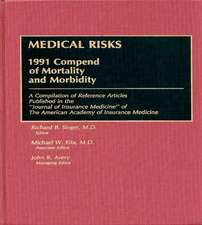Who's in Charge?: Leadership during Epidemics, Bioterror Attacks, and Other Public Health Crises: Praeger Security International
Autor Laura H. Kahnen Limba Engleză Paperback – 15 apr 2020 – vârsta până la 17 ani
| Toate formatele și edițiile | Preț | Express |
|---|---|---|
| Paperback (1) | 173.04 lei 6-8 săpt. | |
| Bloomsbury Publishing – 15 apr 2020 | 173.04 lei 6-8 săpt. | |
| Hardback (1) | 322.02 lei 6-8 săpt. | |
| Bloomsbury Publishing – 2 sep 2009 | 322.02 lei 6-8 săpt. |
Din seria Praeger Security International
- 18%
 Preț: 334.19 lei
Preț: 334.19 lei - 8%
 Preț: 335.53 lei
Preț: 335.53 lei - 34%
 Preț: 376.10 lei
Preț: 376.10 lei - 46%
 Preț: 443.64 lei
Preț: 443.64 lei - 29%
 Preț: 240.11 lei
Preț: 240.11 lei - 8%
 Preț: 304.56 lei
Preț: 304.56 lei - 34%
 Preț: 373.82 lei
Preț: 373.82 lei - 19%
 Preț: 412.79 lei
Preț: 412.79 lei - 19%
 Preț: 338.42 lei
Preț: 338.42 lei - 18%
 Preț: 335.62 lei
Preț: 335.62 lei - 27%
 Preț: 377.35 lei
Preț: 377.35 lei - 27%
 Preț: 376.75 lei
Preț: 376.75 lei - 18%
 Preț: 336.46 lei
Preț: 336.46 lei - 18%
 Preț: 321.73 lei
Preț: 321.73 lei - 27%
 Preț: 384.51 lei
Preț: 384.51 lei - 18%
 Preț: 320.50 lei
Preț: 320.50 lei - 18%
 Preț: 320.50 lei
Preț: 320.50 lei - 18%
 Preț: 321.35 lei
Preț: 321.35 lei - 24%
 Preț: 420.54 lei
Preț: 420.54 lei - 14%
 Preț: 335.99 lei
Preț: 335.99 lei - 18%
 Preț: 355.82 lei
Preț: 355.82 lei - 18%
 Preț: 319.83 lei
Preț: 319.83 lei - 18%
 Preț: 334.28 lei
Preț: 334.28 lei - 32%
 Preț: 354.48 lei
Preț: 354.48 lei - 14%
 Preț: 335.14 lei
Preț: 335.14 lei - 38%
 Preț: 405.98 lei
Preț: 405.98 lei - 40%
 Preț: 571.34 lei
Preț: 571.34 lei - 18%
 Preț: 321.85 lei
Preț: 321.85 lei - 18%
 Preț: 323.25 lei
Preț: 323.25 lei - 18%
 Preț: 253.28 lei
Preț: 253.28 lei - 40%
 Preț: 571.50 lei
Preț: 571.50 lei - 14%
 Preț: 333.72 lei
Preț: 333.72 lei - 18%
 Preț: 301.73 lei
Preț: 301.73 lei - 19%
 Preț: 352.96 lei
Preț: 352.96 lei - 26%
 Preț: 387.80 lei
Preț: 387.80 lei - 18%
 Preț: 302.77 lei
Preț: 302.77 lei - 14%
 Preț: 333.91 lei
Preț: 333.91 lei - 17%
 Preț: 325.80 lei
Preț: 325.80 lei - 24%
 Preț: 338.58 lei
Preț: 338.58 lei - 34%
 Preț: 414.73 lei
Preț: 414.73 lei - 18%
 Preț: 354.30 lei
Preț: 354.30 lei - 29%
 Preț: 254.29 lei
Preț: 254.29 lei - 18%
 Preț: 354.11 lei
Preț: 354.11 lei - 18%
 Preț: 334.38 lei
Preț: 334.38 lei - 14%
 Preț: 302.68 lei
Preț: 302.68 lei - 18%
 Preț: 322.97 lei
Preț: 322.97 lei - 27%
 Preț: 376.50 lei
Preț: 376.50 lei - 27%
 Preț: 322.81 lei
Preț: 322.81 lei - 27%
 Preț: 382.91 lei
Preț: 382.91 lei - 18%
 Preț: 320.87 lei
Preț: 320.87 lei
Preț: 173.04 lei
Preț vechi: 248.87 lei
-30% Nou
Puncte Express: 260
Preț estimativ în valută:
33.11€ • 34.66$ • 27.40£
33.11€ • 34.66$ • 27.40£
Carte tipărită la comandă
Livrare economică 05-19 aprilie
Preluare comenzi: 021 569.72.76
Specificații
ISBN-13: 9781440878176
ISBN-10: 144087817X
Pagini: 266
Dimensiuni: 156 x 235 x 14 mm
Greutate: 0.38 kg
Ediția:2
Editura: Bloomsbury Publishing
Colecția Praeger
Seria Praeger Security International
Locul publicării:New York, United States
ISBN-10: 144087817X
Pagini: 266
Dimensiuni: 156 x 235 x 14 mm
Greutate: 0.38 kg
Ediția:2
Editura: Bloomsbury Publishing
Colecția Praeger
Seria Praeger Security International
Locul publicării:New York, United States
Caracteristici
First-person accounts from leaders involved in actual early-21st-century crises, as well as leading experts, scientists, and others
Notă biografică
Laura H. Kahn, MD, MPH, MPP is a physician and research scholar in the Program on Science and Global Security at the Woodrow Wilson School of Public and International Affairs at Princeton University.
Cuprins
PrefaceAcknowledgments1. Understanding LeadershipAn Overview of LeadershipStudying Public Health LeadershipPolitical Leaders and BureaucratsDefining Leadership2. The Long March to Improving the Public's HealthInfectious Disease EpidemicsVaccines: A Fortunate CoincidenceAn Unfortunate Side Effect of HospitalsEarly Public Health Epidemics in the Newly Formed United StatesSweeping Social Changes in EuropeThe Father of EpidemiologyCrossing Borders: European Influences on Early American Public Health EffortsAwakenings: A Long-Awaited BreakthroughThe Germ Theory of DiseaseThe Civil War and the Changing Face of U.S. Public HealthPostwar Public Health DevelopmentsThe Beginnings of International HealthPandemic Influenza in the Early 20th CenturyThe Beginnings of the World Health OrganizationThe HIV/AIDS PandemicPublic Health Past, Present, and Future3. Microbes as WeaponsBiowarfare and Bioterrorism through the AgesAdvances in the 20th CenturyThe Role of the United StatesThe Role of the Soviet UnionTerrorist Acts by Groups and IndividualsEmerging Concerns4. Rising to the OccasionPolitical Leadership during Infectious Disease CrisesAnthrax Attack, Fall 2001, Hamilton Township, New JerseyMayor Glen D. Gilmore, Hamilton Township, New JerseyCryptosporidium Outbreak, Spring 1993, Milwaukee, WisconsinMayor John Norquist, Milwaukee, WisconsinSevere Acute Respiratory Syndrome (SARS), Spring 2003, Toronto, CanadaDeputy Mayor Case Ootes, Toronto, CanadaConclusion5. Success Favors the Prepared Public Health LeaderAnthrax Attacks in New Jersey, Florida, Maryland, and New YorkNew JerseyFloridaMarylandNew York CityCryptosporidium in Milwaukee, WisconsinSARS in Toronto, CanadaConclusion6. Confronting UncertaintyThe 1976-77 Swine Flu DilemmaThe 1997 Avian Flu DilemmaThe 2009 Swine Flu DilemmaLeaders' Responses to Disease ThreatsInformation Required for Decision MakingConclusion7. Part I: The Vital Link between Animal and Human HealthThe Impact of Animal Health CrisesBovine Spongiform Encephalopathy (BSE)Views of the CrisisConclusionPart II: The Vital Link between Animal and Human HealthThe Foot-and-Mouth Disease CrisisViews of the CrisisSumming UpConclusion8. Reaching the MassesRisk Assessment, Perception, and CommunicationSmallpox Outbreak in New York City, 1947The Changing MediaFrom the Media PerspectiveAnthrax Outbreak in New Jersey, 2001Cryptosporidium Outbreak in Wisconsin, 1993SARS Outbreak in Toronto, 2003Conclusion9. All Hands on DeckWorst Case ScenariosLegal Challenges of Public Health and BioterrorismImproving PreparednessA Better ModelExperts' AdvicePublic Health and Emergency ManagementWho's in Charge?Epidemics and Bioterrorist Attacks: Leadership ChallengesPublic Health, the Military, and the National GuardConclusion10. ConclusionCritical Need: Prepared Elected OfficialsRelationships between LeadersWhen Science Does Not Have the AnswersThe Public Communication Roles of Different LeadersLegal and Organizational Structures and Crisis LeadershipTraining Elected OfficialsNotesIndex
Recenzii
A perfect text for schools in public health, or as a reference for elected officials at every level of government, the book shows how each event developed step-by-step to pinpoint specific leadership issues. Engaging and absorbing, the work presents official reports, medical literature, first-person accounts from officials and journalists, and discussions of the role of law enforcement and the military during health care emergencies.
The book can be used as a supplemental text for courses in public health, or as a reference for elected officials at every level.
Kahn's examples of the generalities between the political and bureaucratic gravity fields in government is expanded in the first few chapters into an excellent framework of historical facts and lessons learned. . . . If you want to better understand the 'how' and 'why' behind the United States' health care responses to H1N1 Influenza Outbreak and the Haitian earthquake disaster, read this book!
This well-written, thoroughly researched, and authoritative book will interest public health and medical professionals and public policy students, along with the general public. Recommended. Lower-level undergraduates and above; general readers.
Who's in Charge? is written in an easy, informal style that can be understood by readers with minimal knowledge about medicine and public health..the content is strong, and the result is a useful, thought-provoking book and valuable resource for public officials. The volume also raises a number of important policy issues that warrant attention and action-or at least serious reflection-by those likely to be in charge the next time disaster comes calling.
Who's in Charge? Leadership During Epidemics, Bioterror Attacks, and Other Public Health Crises is a well researched and easily readable book that offers valuable insight into many leadership challenges that politicians, health authorities, and medical scientists faced when dealing with some large and widely publicized health crises. . This text is a valuable contribution.
The book can be used as a supplemental text for courses in public health, or as a reference for elected officials at every level.
Kahn's examples of the generalities between the political and bureaucratic gravity fields in government is expanded in the first few chapters into an excellent framework of historical facts and lessons learned. . . . If you want to better understand the 'how' and 'why' behind the United States' health care responses to H1N1 Influenza Outbreak and the Haitian earthquake disaster, read this book!
This well-written, thoroughly researched, and authoritative book will interest public health and medical professionals and public policy students, along with the general public. Recommended. Lower-level undergraduates and above; general readers.
Who's in Charge? is written in an easy, informal style that can be understood by readers with minimal knowledge about medicine and public health..the content is strong, and the result is a useful, thought-provoking book and valuable resource for public officials. The volume also raises a number of important policy issues that warrant attention and action-or at least serious reflection-by those likely to be in charge the next time disaster comes calling.
Who's in Charge? Leadership During Epidemics, Bioterror Attacks, and Other Public Health Crises is a well researched and easily readable book that offers valuable insight into many leadership challenges that politicians, health authorities, and medical scientists faced when dealing with some large and widely publicized health crises. . This text is a valuable contribution.











